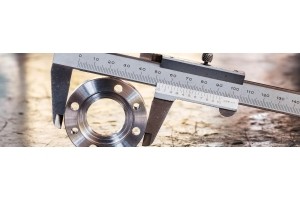- Material
-
- Aluminium 61
- Brass 8
- Stainless Steel 8
- Galvanised Steel 1
- Mild Steel 1
Galvanised Steel vs Stainless Steel in UK Construction
When selecting construction materials, steel remains a cornerstone of durability and structural integrity. Yet, although steel is the clear choice, choosing between galvanised steel and stainless steel isn’t quite as simple. For one, it is not just about cost but how well your structure will resist moisture, salt, and environmental stress over time.
Rust and deterioration can result in unexpected maintenance costs and a shorter lifespan. Therefore, it is essential to pick the right steel for the job. Stainless steel is excellent at resisting corrosion, but its higher price isn’t always worthwhile. On the other hand, galvanised steel delivers affordable durability. This makes it a preferred choice for framing, fencing, and industrial applications. So, which do you choose?
This guide highlights the main benefits and uses of galvanised steel. It also looks at its sustainability and compares it to stainless steel.
What’s the Difference Between Galvanised Steel & Stainless Steel?
Grasping the manufacturing processes of each material is essential for picking the right steel for your project. In short, Galvanised steel is carbon steel coated in zinc to prevent rust. Stainless steel contains 10.5% chromium, which naturally resists corrosion without the need for a coating.
Galvanised Steel
Galvanised steel begins as carbon steel, hot-dipped in molten zinc to form a protective barrier. This zinc coating serves as a sacrificial layer, protecting against rust when exposed to moisture or oxygen. Galvanised steel is popular in UK construction projects because it is both affordable and performs well. The material is typically used in everything from industrial framing to agricultural infrastructure.
Stainless Steel
Unlike galvanised steel, stainless steel contains at least 10.5% chromium. This creates a natural, self-healing layer that resists rust. Best of all, it achieves this without requiring additional coatings. Stainless steel's strong resistance makes it ideal for humid, salty, or chemically rich environments. This includes marine structures and food-grade facilities.
Benefits of Galvanised Steel in Construction
Galvanised steel is a staple material in UK construction. It is affordable, durable, and easy to work with. Its zinc coating offers strong protection against corrosion. This helps structures last longer and reduces the need for expensive maintenance.
Key advantages include:
- The zinc barrier shields steel from moisture, slowing rust formation.
- Offers an economical solution for infrastructure projects, reducing upfront costs.
- It can be cut, welded, and shaped on-site without specialised tools.
- Particularly suitable for internal or moderate exposure environments.
- Galvanised steel is recyclable, contributing to eco-friendly construction.
Where galvanised steel works best:
- Protects industrial and warehouse structures against UK weather fluctuations.
- It holds up well in both residential and commercial applications, such as fencing, gates, and railings.
- It is ideal for cost-conscious yet robust construction, like structural beams and framing.
- Durable and reliable for securing load-bearing structures, like fixings and brackets.
- Strong enough to withstand outdoor conditions, including damp environments.
Galvanised steel is particularly suited for moderate exposure environments. However, it is less effective in marine or chemical-heavy areas.
When Stainless Steel is the Better Choice
While galvanised steel offers excellent protection, stainless steel excels in harsher conditions, where both longevity and appearance are important.
Key advantages of stainless steel:
- Performs well in coastal, industrial, and chemical-rich environments.
- A sleek, modern finish makes it popular for facades, handrails, and high-visibility areas.
- Favoured in hospitals, food processing, and cleanroom environments.
- It requires no recoating or treatment, making it cost-effective over time.
- Often outlasts galvanised steel, especially in high-salinity or high-traffic areas.
Where stainless steel excels:
- As it’s resistant to saltwater corrosion, it’s best suited to coastal infrastructure.
- Its aesthetic appeal and durability make it suitable for public buildings and interiors.
- Naturally hygienic and non-reactive, it’s used in food processing and medical facilities.
- Combining strength with premium design for architectural cladding and balustrades.
- Chemical and wastewater plants utilise it because it withstands aggressive environmental conditions.
For key applications that require long-term performance, stainless steel is the best choice, even though it may initially be more expensive.
Environmental Considerations & Longevity
Galvanised steel and stainless steel both contribute to sustainable construction, but they do so in different ways.
Galvanised Steel = Affordable Sustainability
Galvanised steel is both durable and recyclable. This makes it a wise choice for budget-friendly projects that prioritise environmental concerns. Its zinc coating extends the material’s lifespan, and when properly maintained, structures can last for decades.
- Zinc and steel components can be recovered and repurposed, reducing waste.
- Protective coatings delay the need for replacement.
- Galvanisation requires less energy than producing stainless steel, lowering its carbon footprint.
In Construction 2025 Industrial Strategy, GOV.UK reported that 60% of UK industrial projects use galvanised steel for long-term cost savings and weather resistance.
Stainless Steel = Longevity with Full Recyclability
Stainless steel has a larger production footprint, but it is very durable. This means structures can last longer and need less maintenance.
- 100% recyclable and retains its properties indefinitely, ensuring zero material degradation.
- There is no need for recoating, reducing chemical usage and repairing waste.
- It is ideal for projects requiring long service life, such as hospitals or marine infrastructure.
In their Net Zero Whole Life Carbon Roadmap, the UK Green Building Council not only states that stainless steel has a long lifespan. They say that this makes it great for coastal and healthcare buildings, as it cuts replacement costs in the long run.
How Long Does Galvanised Steel Last?
Galvanised steel is regular steel that has been given a zinc coating to make it more resistant to corrosion. The zinc layer acts as a sacrificial barrier, protecting the steel underneath from rust when it comes into contact with oxygen and moisture.
Generally, galvanised steel lasts between 25 to 50 years before it starts losing its integrity. The exact lifespan depends on a few factors:
- Type of galvanisation: There are four main methods of steel galvanisation, and which one you choose has a big impact on the metal’s lifespan. Hot-dip galvanising lasts the longest, while electrogalvanising lasts the shortest. Sherardising and thermal spraying fall somewhere in the middle.
- Environment: Galvanised steel will last longer in drier, less polluted environments. Sea air and road salts will wear down the zinc coating and accelerate corrosion, shortening the metal’s lifespan.
- Coat thickness: Thicker, more uniform coatings will last longer as the zinc will take more time to wear down.
How Long Does Stainless Steel Last?
Stainless steel is a metal alloy, meaning it's a mixture of several elements. The main components of stainless steel are iron and chromium, with chromium making up at least 10.5% of the alloy. Chromium is what gives stainless steel its trademark corrosion resistance. When chromium comes into contact with oxygen, it forms a thin layer of chromium oxide on the surface of the steel. This layer is invisible and very thin, but it's incredibly effective at protecting the steel from rust and corrosion.
In general, you can expect stainless steel to retain its integrity for over 50 years, though it can take much longer to break down completely.
Like galvanised steel, its exact lifespan depends on several factors:
- Grade of stainless steel: There are various types of stainless steel, each with different chromium and nickel content. Higher chromium and nickel content generally lead to better corrosion resistance and a longer lifespan.
- Environment: Stainless steel lasts longer in drier, inland areas with minimal pollution. Harsh environments like marine areas with salt spray or industrial settings with high chemical exposure can reduce its lifespan.
- Maintenance: Regular cleaning to remove dirt and debris that can trap moisture and promote corrosion can extend the lifespan.
Choosing the Right Steel for Your Project
Selecting steel for construction requires evaluating environmental exposure, maintenance needs, and budget constraints. On the one hand, galvanised steel offers durable affordability. This makes it suitable for structural framing, fencing, and industrial applications. However, stainless steel provides corrosion resistance and aesthetic quality. This makes it effective for high-exposure environments and architectural finishes.
With over 70 years' experience within the metals industry Clickmetal’s team is here to help. Still concerned about your project’s needs? Here is our top tip: weather conditions and lifespan helps professionals pick the best steel. A well-informed decision ensures strong performance and lasting value in the construction industry.
Call 01794 526090 or explore our premium galvanised steel and stainless steel products for your next build today.












